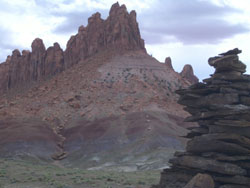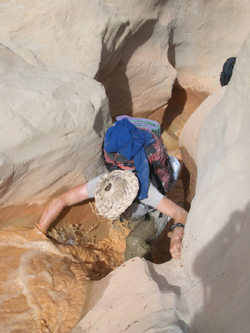Meandering Through Red Cliffs
Day 60
Greetings from the start of the 12th section of the Hayduke Trail. We’ve now been under the rim of this massive network of colorful drainages for a week, and while we’ve encountered a number of boaters, we have yet to see a single hiker! And this place is paradise! That’s not to say that it’s easy going—it’s not. But since we left the Little Colorado, it’s all been on trails, so route finding at least is easier.
Five us of left Paradise Creek a few days ago, and we followed the Beamer Trail to its end at Tanner Canyon, which began the “Escalante Route” that we’d finished at Hance Rapid. The walk was easy for four of us. We went to Cardenas Camp, while Ray chose to burn some energy and hike up Tanner Trail to the rim. While Ray sweated his way to a successful mission, the rest of us sat in the shade of willow or tamarisk trees with our feet in the chilly water of the Colorado River.
The way to Hance brought us high above the river on a well worn trail. The view was nothing short of spectacular; we were able to look upstream into the wide part of the gorge that we had passed through, the Grand Canyon “supergroups.” An enormous geologic unconformity dominates the erosive character, as well as a view into the upper Granite Gorge by Hance rapid, where the canyon narrows greatly, home to some of the river’s biggest rapids.
The rest of the Escalante route was not so friendly, matching neither my memory of our passage in 2000, nor that of the description in our guide. There were three separate times the trail came down to the river, only to climb well above the water again. The one bright spot was when the route passed through the narrows of Seventy-Five Mile Creek.
Ravens made their presence known again; we found out that they know how to open backpacks and zippers! Fortunately, these intelligent pests mostly found our garbage, but Ray once again lost part of dinner. Another critter has been conspicuously absent, but that’s been fine. We’ve only seen exactly half of one rattlesnake so far. The tail end of a small rattler was found lying across the middle of the trail.
The travel in the Grand Canyon has been tough, but the scenery is beyond what the imagination could fabricate. The scale is unbelievable. So far, the weather has been remarkably cooperative, the nights cool (in the 50’s), the heat in the shade hasn’t even cracked 90. It’s been so much more comfortable than the expected 20 degrees warmer, but Ray and I still lost the rest of our comrades to the Hance Trail, all opting to head to the rim. We’ll miss their companionship and conversation!
Grand View Trail, which leads from the rim to our brief home on Horseshoe Mesa, has been closed since February; a section of the trail in the Coconino layer slid into the abyss—as they say, this place is falling apart! We figured it’s been since February anyway, there’s no fresh sign of folks anywhere, and the last entry in the register in the Cave of the Domes was February. Ray and I spent a couple of hours exploring that cave, which is much larger than I would have guessed from my previous visit, and far more spectacular than I would have dreamed!
Of course, the ravens took advantage of our absence and tried to raid our packs again. All they got from my pack was some black pepper, which they must not like—I found the shaker 40 feet away.
Day 61
I’m sitting and looking at one gorgeous sunset; the Palisade Cliffs to the east are cherry red as they catch the last rays of the sun, which is sinking over the most fascinating horizon line one could ask for. I’m perched on the Tonto layer, almost 2,000 feet above the river, overlooking a fair amount of the Granite Gorge. The river is pale green as it snakes through the jagged brown, red, pink and white ridges that are part of the 1.8 billion year old schist. Grapevine Creek rapids are below us, while its namesake canyon climbs behind. Across the river are countless temples, mesas, buttes, points, promontories, etc that form the mess below the North Rim. Cape Royal is across from us, as it has been for three days now, being near the hub of the semi-circle that the river makes here.
As the sunset fades to dark, the thinnest of crescent moons is revealed just above the dwindling light. How lucky are we to witness such an amazing spectacle in such an amazing place?
We were talking about how river miles seem deceptive at times; because of a meander, a river might travel for a couple, or even several miles to move a quarter of a linear mile. Today, our nine miles got us all of two river miles! Oh yeah, we finally saw a comatose Grand Canyon pink rattler.
Day 62
Another day on the Tonto Trail, and it went quickly, at least our miles did. After another perfect night, with temps in the upper 50’s, and enough stars to practically see color on this moonless evening, we hoisted our now lightweight packs and moved on. We finally saw a couple of hikers out; they informed us that water was available in all the drainages we’d be passing, so our water load is minimal, and our food supply is dwindling.
We’re now having a siesta at Cremation Creek. Tomorrow, we’ll pass through Phantom Ranch, where I will post this letter myself. We’re having a grand time in the Grand Canyon!
Keep It Wild,
Mike Coronella





 Subscribe to Mike and Mitch's RSS Feed
Subscribe to Mike and Mitch's RSS Feed
